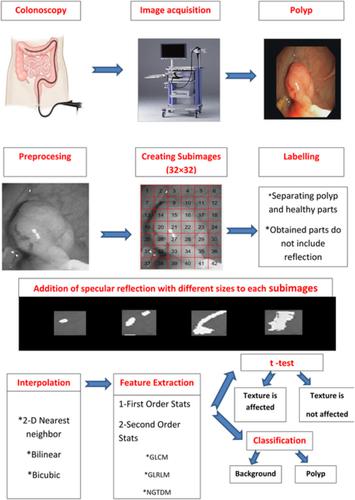当前位置:
X-MOL 学术
›
Int. J. Imaging Syst. Technol.
›
论文详情
Our official English website, www.x-mol.net, welcomes your
feedback! (Note: you will need to create a separate account there.)
Effect of interpolation on specular reflections in texture‐based automatic colonic polyp detection
International Journal of Imaging Systems and Technology ( IF 3.0 ) Pub Date : 2020-06-26 , DOI: 10.1002/ima.22457 Rukiye Nur Kaçmaz 1, 2 , Bülent Yılmaz 1, 2, 3 , Zafer Aydın 1, 4
International Journal of Imaging Systems and Technology ( IF 3.0 ) Pub Date : 2020-06-26 , DOI: 10.1002/ima.22457 Rukiye Nur Kaçmaz 1, 2 , Bülent Yılmaz 1, 2, 3 , Zafer Aydın 1, 4
Affiliation

|
Reflections of LED light cause unwanted noise effects called specular reflection (SR) on colonoscopic images. The aim of this study was to seek answers to the following two questions. (a) How are the texture features used in automatic detection of polyps affected by the interpolation on specular reflections? (b) If they are affected does it really affect the classification performance? In order to answer these questions, we used 610 colonoscopy images, and divided each image into tiles whose sizes were 32‐by‐32 pixels. From these tiles, we selected the ones without any specular reflection. We added different shape and size specular reflections cropped from real images onto the reflection‐free tiles. We then used the nearest neighbors, bilinear and bicubic interpolation techniques on the tiles on which SRs were added. On these tiles we extracted 116 texture features using 3 second‐order approaches, and 4 first‐order statistics. First, we used paired sample t test. Second, we performed automatic classification of polyps and background using random forest and k nearest neighbors (k‐NN) approaches using the texture features for different combinations of specular reflections added on the tiles from the polyp or background. The results showed that depending on the size of specular reflection, interpolation can cause a significant difference between the texture features that were coming from reflection‐free tiles and the same tiles on which interpolation was performed. In addition, we note that bicubic interpolation may be preferred to eliminate specular reflection when texture features are used for background and polyp discrimination.
中文翻译:

基于纹理的自动结肠息肉自动检测中插值对镜面反射的影响
LED的反射会在结肠镜图像上产生有害的噪声效应,称为镜面反射(SR)。这项研究的目的是寻找以下两个问题的答案。(a)自动检测息肉中使用的纹理特征受到镜面反射插值的影响吗?(b)如果它们受到影响,是否真的影响分类性能?为了回答这些问题,我们使用了610幅结肠镜检查图像,并将每个图像划分为大小为32 x 32像素的图块。从这些图块中,我们选择了没有任何镜面反射的图块。我们将从真实图像裁剪的不同形状和大小的镜面反射添加到了无反射图块上。然后,我们在添加SR的图块上使用了最近邻,双线性和双三次插值技术。在这些图块上,我们使用3种二阶方法和4种一阶统计量提取了116个纹理特征。首先,我们使用配对样本t测试。其次,我们使用随机森林和k最近邻(k-NN)方法对息肉和背景进行自动分类,k方法使用纹理特征针对从息肉或背景添加到图块上的镜面反射的不同组合进行了分类。结果表明,根据镜面反射的大小,插值可能会导致来自无反射图块的纹理特征与执行插值的相同图块之间存在明显差异。另外,我们注意到,当纹理特征用于背景和息肉鉴别时,双三次插值法可能更适合消除镜面反射。
更新日期:2020-06-26
中文翻译:

基于纹理的自动结肠息肉自动检测中插值对镜面反射的影响
LED的反射会在结肠镜图像上产生有害的噪声效应,称为镜面反射(SR)。这项研究的目的是寻找以下两个问题的答案。(a)自动检测息肉中使用的纹理特征受到镜面反射插值的影响吗?(b)如果它们受到影响,是否真的影响分类性能?为了回答这些问题,我们使用了610幅结肠镜检查图像,并将每个图像划分为大小为32 x 32像素的图块。从这些图块中,我们选择了没有任何镜面反射的图块。我们将从真实图像裁剪的不同形状和大小的镜面反射添加到了无反射图块上。然后,我们在添加SR的图块上使用了最近邻,双线性和双三次插值技术。在这些图块上,我们使用3种二阶方法和4种一阶统计量提取了116个纹理特征。首先,我们使用配对样本t测试。其次,我们使用随机森林和k最近邻(k-NN)方法对息肉和背景进行自动分类,k方法使用纹理特征针对从息肉或背景添加到图块上的镜面反射的不同组合进行了分类。结果表明,根据镜面反射的大小,插值可能会导致来自无反射图块的纹理特征与执行插值的相同图块之间存在明显差异。另外,我们注意到,当纹理特征用于背景和息肉鉴别时,双三次插值法可能更适合消除镜面反射。











































 京公网安备 11010802027423号
京公网安备 11010802027423号